Unlocking the Secrets of FDM: The Magic Behind 3D Printing!
3D printing has revolutionized the way we create and manufacture objects, gaining immense popularity across various industries and among hobbyists alike. One of the most prominent techniques in this realm is Fused Deposition Modeling (FDM), a method that has become synonymous with affordable and accessible 3D printing. In this article, we will delve into the concept of FDM, exploring its significance in the 3D printing landscape and the fundamental principles that drive this fascinating technology. By the end, you'll have a comprehensive understanding of what FDM means in the context of 3D printing and how it works, along with insights into its applications, advantages, and limitations.

Understanding FDM: The Basics
Fused Deposition Modeling (FDM) is a 3D printing technology that builds objects layer by layer through the controlled extrusion of thermoplastic materials. This method relies on a digital model that is sliced into thin horizontal layers, allowing for precise control over the printing process. The origins of FDM date back to the late 1980s when it was pioneered by a company that sought to create rapid prototyping solutions. Over the years, FDM has evolved into one of the most widely used 3D printing methods, praised for its simplicity and effectiveness. It has become a go-to choice for both professionals and enthusiasts, playing a pivotal role in the broader evolution of 3D printing technologies.
How FDM Works
The FDM process begins with a digital model, often created using computer-aided design (CAD) software. Once the model is ready, it is sliced into numerous horizontal layers through slicing software. This software converts the 3D design into a set of instructions that the printer can understand. The printing process itself involves feeding a thermoplastic filament into a heated nozzle, where it is melted and extruded onto a build platform. This layer-by-layer approach continues until the entire object is formed. The most common materials used in FDM are thermoplastics such as PLA (Polylactic Acid) and ABS (Acrylonitrile Butadiene Styrene), each offering unique properties that cater to different applications. As the filament cools and solidifies, it bonds with the previous layer, resulting in a durable 3D object.
The FDM Printing Process
The FDM printing process can be broken down into several key stages: model design, slicing, and printing. Initially, the designer creates a 3D model using CAD software, ensuring that it meets the required specifications. Next, the slicing software takes this model and divides it into layers, generating G-code, which instructs the printer on how to move, where to extrude material, and other critical parameters. Finally, the printer executes these instructions, carefully depositing filament to construct the object layer by layer. Software plays a crucial role in this process, enhancing the printer's capabilities and ensuring accuracy throughout the print.
Applications of FDM in Various Industries
FDM technology has found applications across a multitude of sectors, showcasing its versatility and efficiency. In prototyping, designers can quickly create and test models before moving to full-scale production, significantly reducing lead times. In manufacturing, FDM is utilized for creating custom tools, fixtures, and parts, enhancing production efficiency and flexibility. The healthcare sector benefits from FDM through the creation of personalized medical devices and anatomical models used for surgical planning. Additionally, educational institutions leverage FDM to provide hands-on learning experiences in STEM fields, encouraging innovation and creativity among students. Each of these applications demonstrates how FDM is revolutionizing traditional processes, making them more efficient and tailored to specific needs.
Advantages and Limitations of FDM
The advantages of FDM technology are numerous. One of the most significant benefits is its cost-effectiveness, making it accessible to a wide range of users, from hobbyists to large enterprises. The materials used in FDM printing are generally affordable and readily available, contributing to its popularity. Furthermore, the technology is relatively easy to use, allowing newcomers to grasp its concepts quickly. However, FDM does have limitations; print speed can be slower compared to other methods, particularly for larger objects. Additionally, the choice of materials can sometimes constrain the properties of the final product, as not all thermoplastics are suitable for every application. Understanding these advantages and limitations is essential for effectively utilizing FDM in various projects.
Key Takeaways on FDM Technology
In summary, Fused Deposition Modeling (FDM) is a cornerstone of the 3D printing world, offering an affordable and accessible method for creating intricate designs and prototypes. We explored the basics of FDM, how it works, its applications in various fields, and the advantages and limitations that come with this technology. As 3D printing continues to evolve, understanding FDM becomes increasingly important for anyone looking to explore and harness the potential of this innovative technique. Whether you're a seasoned professional or a curious beginner, FDM technology opens up a world of possibilities for creativity and invention in your projects.



